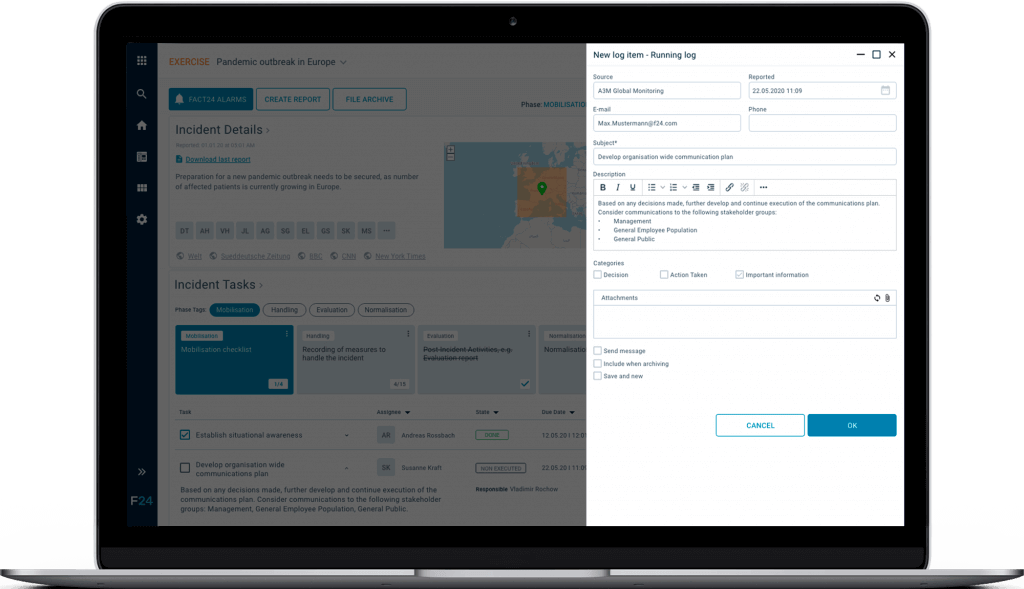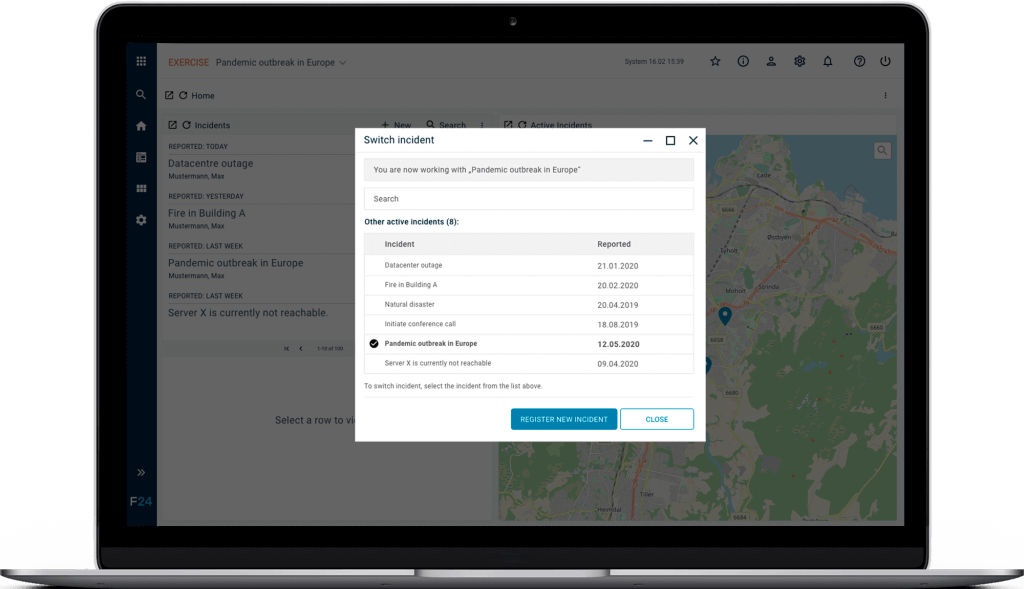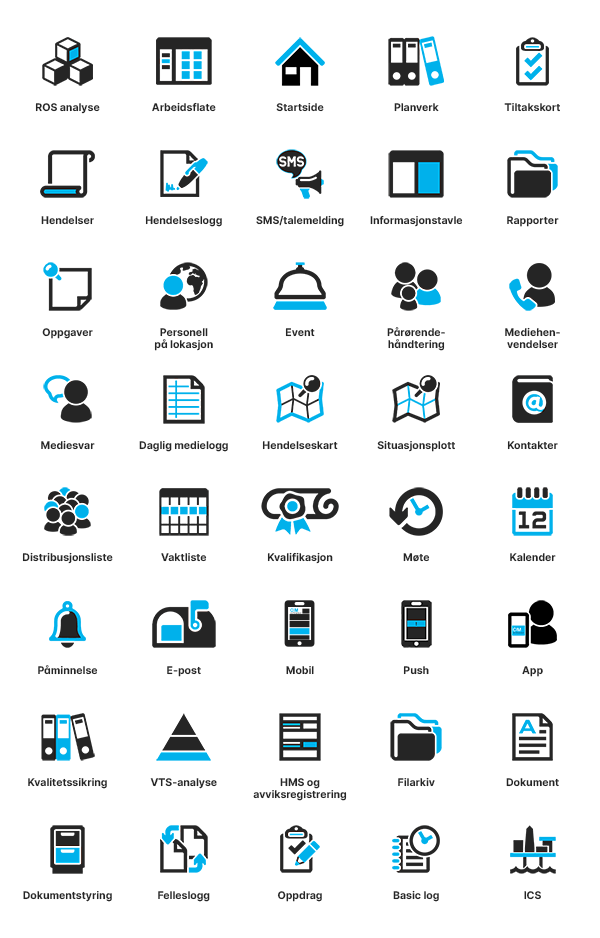CIM – comprehensive crisis management system
Avoiding all surprises and eliminate all risks is impossible, but you can increase your readiness. Good Risk and Vulnerability Analyses can to a certain degree predict incidents that can affect your organisation. No two incidents are alike, and an incident can occur when you least expect it. Effective and updated plans are important – and they must be in place before the crises occur.
Why do we call CIM a comprehensive crisis management system? Because it supports all processes in crisis management:
- CIM can contribute to AWARENESS in your organisation, about threats, essential routines and procedures, government regulations, and best practice.
- You can increase SECURITY and SAFETY by storing plans, action cards and routines in one place. Those who have responsibilities when an incident occurs know what to do, whom to contact and which resources they have at their disposal.
- You get the ability to ACT and handle the incident, since all those involved have dedicated tasks and responsibilities. All activities are logged and can be traced. All actions and functions during an incident can be handled in one system.
- When you return to normal after an incident, anything you have done has been logged and stored, so you can analyse and IMPROVE your incident management.
No two organisations are alike – this also goes for crisis and incident management. The need for flexibility in a crisis management system is the reason why F24 has developed a system that can make use of up to 40 modules to cover your specific needs. We also understand that you already may have implemented other tools or systems that take care of some of the needs that the CIM modules cover. Because of this, we have also developed a series of integrations that make it possible to connect your existing systems with CIM.
Most of the CIM modules are tightly integrated with each other to offer functionality across modules, but we have also developed new modules or integrations for customers. CIM is a standardised product, and although different sets of configurations are used as standard configurations in some sectors, such as the public health sector and the education sector, these are all based on the same technological platform and product. The benefits are obvious – you can build you CIM according to your organisation’s needs; you do not have to change your organisation to fit the tool.
Click on a module to learn more – and please contact us if you need more information.
Tailormade CIM
CIM offers great flexibility, and no two CIM are alike. Our customers range from having between three and several thousand employees, and our more than 1000 installations cover a large range of industries. Some businesses use CIM to control their entire value chain – others just to carry out Risk and Value Analyses. Located at two ends of the scale, these businesses have very different needs when it comes to system users and functionalities.
Sometimes tailoring is needed. Our approach to configuration involves dialogue with the customer on all necessary steps, from specification to development, testing and quality assurance. This way the outcome corresponds with the expectations.
Tailoring a CIM installation often involves making information from other systems available in CIM. CIM supports most standardised formats, and offer specific APIs for integration in some modules.
Integration
Some examples of information that can be integrated into CIM:
- User and contact synchronisation, using LDAP, XML or Web Service
- Media monitoring
- Catalogue services
- Single Sign-On
- Miros weather data
- Map data
- Location services
Contact us if you want to know if we can integrate a particular product you use, into CIM.
Implementing CIM
If you want to achieve the full potential in a new tool, the purchase and implementation process requires a clear purpose and a plan. As when building a new house, you need to decide where to put the necessary rooms and functions, where you want your windows and doors to be, and who should have keys to the house.
At F24 we have broad experience in assisting customers in the implementation of CIM, having done so across a broad range of industries and a multitude of challenges and needs. The customers and their needs are at any rate the most important issue for us.
We have developed a structured, but adaptable implementation process that meets different customers’ needs and requirements. The following structure can be adapted to the individual customer’s needs:
- Internal project start-up meeting in F24
- Project start-up meeting with the customer and F24
- Basic training of the customer’s project group members
- Contribute to the customer’s project plan
- Basic configuration of the customer’s CIM installation
- Assist in further configuration
- Training of the customer’s employees
- Assist in the customer’s project evaluation

Working with risks in CIM
Risks are related to existence and/or activities. Risks are in other words involved in most of what we do. This makes it necessary to identify the areas where the likeliness and consequences of risks should be reduced. A risk and vulnerability analysis and a current risk overview provide important, basic information that is necessary to be able to work systematically and focused on preventing unwanted incidents

Environment Health and Safety in CIM
Preventing accidents from happening is less expensive than handling them when they occur. CIM has tools for reporting, tracking, documenting, and closing nonconformities and unwanted incidents. The system provides a comprehensive approach to your organisation’s environment health and safety work. You can monitor processes, and the system is available for employees that need to access it, independent of time and place.

Readiness in CIM
The term readiness refers to a state of being prepared to handle unexpected crisis situations. When a crisis occurs, staying calm and making the right decisions can be demanding. In a short space of time, you have to get an overview of the situation and take action. You have to prepare for this, and CIM can assist you in doing so.

Alerting and Mobilisation in CIM
Time is a critical factor in emergency situations, whether that be mobilising your team, notifying customers and suppliers of an issue or even sending out a staff welfare check. These days, social media and news outlets will often be the first sources of information for large scale incidents, therefore it is important to ensure that your organisation has tried and tested processes for distributing messages quickly.

Incident and Crisis Management in CIM
When the unexpected happens, it is too late to make plans there and then. No one can fully prevent incidents from happening, but with well-structured preparedness you can limit the damage, take care of those involved and ultimately reduce the impact on your business.

Media and Crisis Communication in CIM
When a crisis unfolds, most media and communications team members have access to too little information or a structured way to respond to incoming enquiries. The pressure exerted by external media agencies and the press in general can be overwhelming- they expect regular updates and will stop at nothing to access the latest information from the organisation affected.
